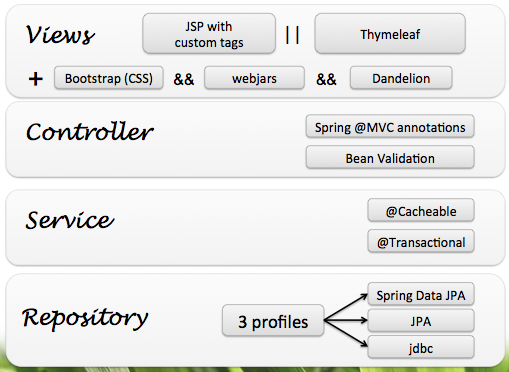This Week in Spring - April 23rd, 2013
Welcome back to another installment of This Week in Spring! Here in San Francisco, we're experiencing the first fits of life and beautiful weather typical of spring time. Fitting, too, as things are busy-as-can-be in the Pivotal open source communities - including Cloud Foundry and SpringSource - as we march towards the Pivotal Initiative launch on April 24th. See you then!
Without further ado, let's get into this week's roundup:
- Have you guys seen the amazing Java configuration support in Spring Batch 2.2.0.RC1? The code I've just linked you to demonstrates a complete working Spring Batch job that reads in a
.csvfile and then writes the records to a data source, all of which are configured in the class, entirely in Java. This demonstrates the@EnableBatchProcessingannotation in 2.2.0. Check it out! - New SpringOne2GX replays now available in HD on YouTube: Implementing Domain Driven Design with Spring and vFabric, Batch Processing and Integration on Cloud Foundry and a bonus session, Understanding Java Garbage Collection and what you can do about it.
- The FuzzyDB open source project tweeted that they'd released a new version of FuzzyDB with Spring Data bindings aligned with the Spring Data Arora release train. Congratulations, guys!
- Have you had a chance to play with Thymeleaf, the HTML5 and Spring MVC-friendly templating engine? If you'd like to learn even more, you'll probably like this presentation called Thymeleaf, Will it Blend?
- David Welch put together a quick demo of Spring Data Mongo and made the work available. He tweets that he went from working demo in 8 minutes with 4 classes and a
pom.xml. Nice work man! - Check out Ramnivas Laddad's awesome talk CloudFoundry Architecture talk at SpringOne2GX up live on the SpringSource YouTube channel SpringSourceDev.
- Spring HATEOAS lead Oliver Gierke tweeted a link to this post, "How I Explained REST to my wife", which would seem at first to be just one person's attempt at explaining a fairly deep technology concept to a person who didn't have the same technical background, but quickly turns into a (I think really insightful) look at the applicability of REST. Check out Spring HATEOAS if you want to take your REST-fu to the next level.
- I'm personally enamored of the new Java configuration APIs, both those recently released and those currently available in preview releases. I showed a very simple example of the Spring Batch API above. I also took a moment last week to write about the powerful Spring Social Java configuration API soon to be available in the 1.1.0.M2 release.
- You can have Spring perform a sort of pre-condition check by using the @Required annotation to insist at runtime that a property be satisfied with a non-
nullvalue, or Spring will abort the construction of the object. This helps avoid any silentNullPointerExceptions. This JavaBeat post does a nice job explaining how to use@Required. - The how to do in java blog has a nice posting on how to create a custom
UserDetailsServicein Spring Security 3. - The JavaCodeGeeks blog has a nice post on how to create RESTful services with Spring MVC.
- Brian's Java Blog has a nice post on using Spring AOP with both annotation and XML-centric configuration options.

